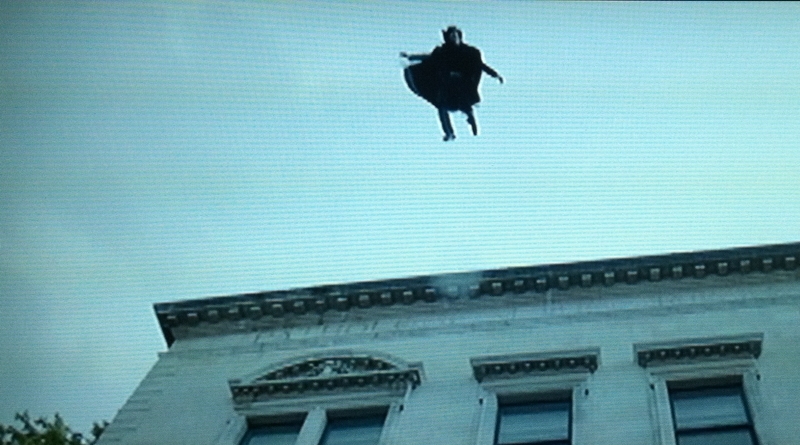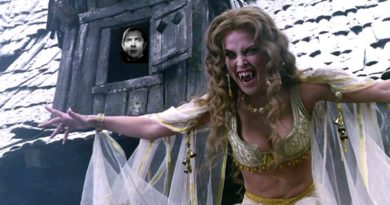Shooting Holes in Sherlock’s Fake Death
“Everything was anticipated, every eventuality was allowed for,” Sherlock Holmes boasts, supposedly spelling out how he faked his death on BBC’s Sherlock.
Rubbish.
The death leap, chronicled in “The Reichenbach Fall,” was ostensibly explained by Holmes at the end of the followup episode, “The Empty Hearse.” Holmes tells an obsessed fan a yarn involving perhaps 20 confederates, many marching about with a giant blue bouncy-house airbag.
C’mon. It’s laughable. It has to be a joke. Viewers immediately suspected as much, because the episode included two even more preposterous possibilities, and the obsessed fan disbelieves and goes bonkers, cackling like a loon.
Seriously, if you’re trying to fool a world full of smart-phone cameras, why use a bright-blue monstrosity and involve enough people for a rock band plus road crew? Is it logical to expect all these accomplices to keep mum, without a single drunken blurt, overheard conversation or bribed confession for two years? No, it’s absurd.
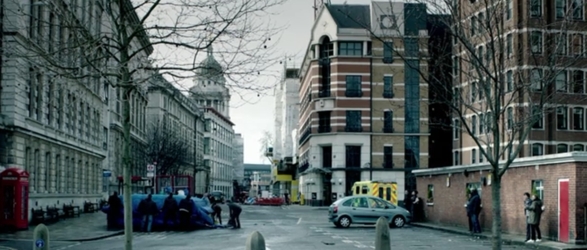
And what about the scores of windows overlooking in the area? Bang! Moriarty (apparently) blows his brains out. Watson screams, “Sherlock!” Nobody would run to a window? Nobody would notice a humongous blue mattress? Or a man falling? Or a corpse tossed onto a sidewalk? Nobody would connect anything to sensational news reports about a famous detective’s suicide leap?
“The whole street was closed off,” Holmes claimed. Perhaps, but no way all those buildings were emptied.
Most of importan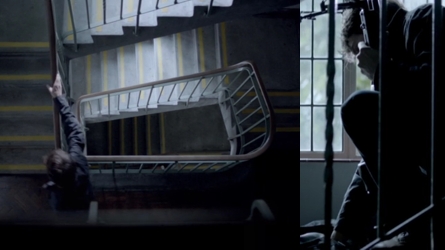 t of all, no way any sniper would have miss the big blue bag. Including with a bullet. Pffffffffft. SPLAT!
t of all, no way any sniper would have miss the big blue bag. Including with a bullet. Pffffffffft. SPLAT!
We know from fleeting images in “The Reichenbach Fall” that the sniper climbed to an upper floor, and the ambulance building was too too low to block any elevated views.
“Every eventuality,” my keister.
Show masterminds Steven Moffat and Mark Gatiss playfully refused to be pinned down during an interview with movie magazine Empire.
Gatiss: The most amazing thing is that reasonable-sounding people have asked, ‘Which of the three theories was the truth?’
Moffat: To which I always reply, ‘The middle one.’ It was an unconvincing dummy with a photograph of Sherlock on the front, and Moriarty and Sherlock eloped. That’s exactly what happened.
No, he’s not being sarcastic. Noooo. The only helpful hints are meager.
Moffatt: He’s got to land, essentially, on a big cushion. …
Gatiss: Now keep in mind that he’s been lying for two years. Who’s to say any version of Sherlock Holmes has told the truth about how he did it?
Good point. We know Holmes does lie to protect his friends and topple villains. He tells Watson in TRF, for instance, that he can’t worry about the life of landlady Mrs. Hudson, because he has to think. No, he wants Watson out of the way so he can’t bollix the rooftop meetup with Moriarty. He lied to John about being a fake. He wove an entire web of deception to apparently lure Moriarty into a trap, perhaps even an inevitably suicidal one.
Also see: How to Solve TV Mysteries Quickly
So let’s assume Holmes’ final solution was a fib. What’s the true one?
My hunch is that Gatiss, Moffatt and Co. realized their original “magic trick” literally came up short. So they decided to present a highly entertaining spoof that kept the mystery alive. And isn’t being puzzled something Sherlock fans love? Guilty here, your honor.
The theory isn’t original, but some of the ideas and evidence may be.
The intention had to be for Holmes to have landed in the passing truck filled with laundry bags.
Yes, Holmes himself denies this to Watson in “The Empty Hearse,” saying, “The first scenario involved hurling myself into a parked hospital van filled with washing bags. Impossible. The angle was too steep.”
Impossible? Really? No, this is the less implausible explanation, for a bunch of reasons.
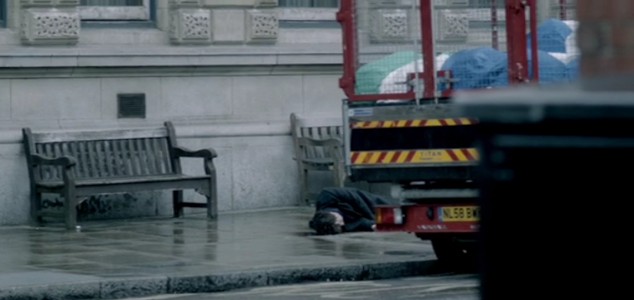
1. We see laundry truck near the body (see photo) in “The Reichenbach Fall.” This image was shown before Watson got knocked down by the cyclist, so only seconds elapsed after the jump. No time for bag cushions Sherlock’s landing, bag ferried away, laundry truck backs up to this position.
2. An aerial view in TRF confirms: The laundry truck (starting to move forward) was where the big blue bag was supposed to be.
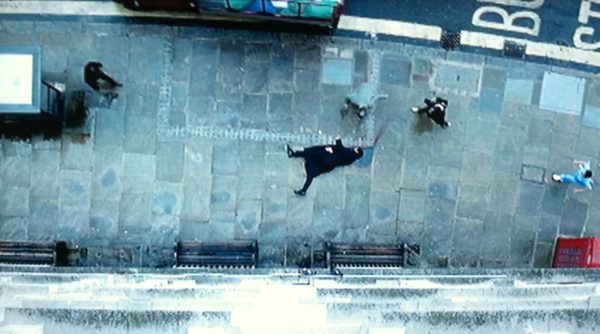
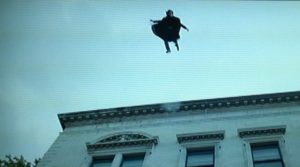 3. Remember the dramatic shot of Holmes in the air FAR away from the building? Why shoot this, unless you’re trying to sell the idea of a long leap forward?
3. Remember the dramatic shot of Holmes in the air FAR away from the building? Why shoot this, unless you’re trying to sell the idea of a long leap forward?
4. This plan might fool witnesses. Nothing unusual about a laundry truck. Tough to be sure from a distance where the body landed. Might even confuse a sniper.
5. Co-conspirators minimized. No need for eight guys to tug-a-lug a big airbag. Theoretically you’d only need a driver, plus Molly and whoever else dumped the body onto the sidewalk. Body might even have been rolled out from under the truck.
6. Holmes could simply be driven away. Did he really need to impersonate his own corpse? Supposedly a Holmes lookalike was discovered/created then killed by Moriarty, and Molly located the body. If it could fool a child, why couldn’t it fool a dazed Watson intentionally jostled by street people? Why have Holmes running about, then have two corpses being taken away? Too much risk of being obvious.
7. The position of the laundry truck in “The Empty Hearse” doesn’t match what viewers saw in “The Reichenbach Fall.” In the top shot below, the cyclist (far upper left) is just starting to come into the frame, Watson has yet to get even with the end of the ambulance station, and the laundry truck is nowhere near the words “BUS STOP,” which is where it was first glimpsed by Watson. In lower image, the bike, the bag, Watson, onlookers all have moved, and yet the truck hasn’t moved any closer to “BUS STOP.”
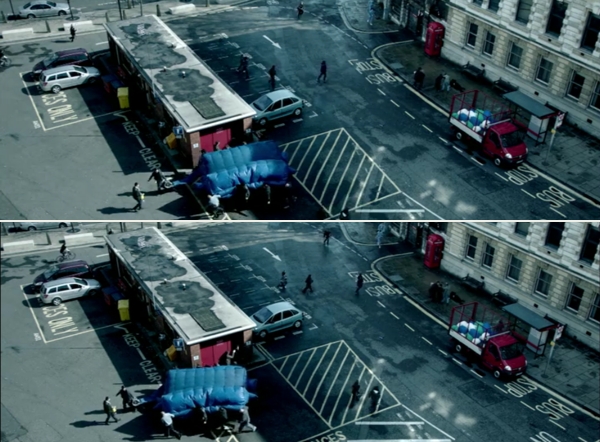
Just a continuity mistake? Maybe, but why is everything else so perfectly in sync?
The Flaw in the Fall and How to Fix It
The suspicion here is the Sherlock folks soured on their original solution, the laundry truck, for several reasons. Fans mostly figured it out, rendering any presentation disappointing. Also, some fans dissed the idea, saying the physics was all wrong, no way Holmes could have made the leap without a running start. Third, it’s small target with only a couple of layers of bags.
They decided, reasonably, it was way more interesting and fun to put forth a new and wilder solution, and let the speculation continue.
But perhaps the laundry truck idea wasn’t so flawed as to be unfixable. Fiction violates physics all the time, and Holmes could sell the math needed to go forward 15 feet while dropping 50. They could say the laundry bags were deeper than they appeared, were filled with air or gel to better cushion Holmes, or were even atop a set of car airbags that inflated upon impact.
Not buying it yet? OK, how about the side of the laundry truck was fitted with an extendable net, like a firemen’s net? Two men jump out of the truck, brace the net with poles (or a detachable section of truck frame), and Holmes hits, hops and lands on the laundry, as the men hook the net back up. Corpse dropped before or after.
Many a professional “magic trick” involves equipment with hidden functions.
Or what if the laundry bags were sewn together like a huge mattress? Side drops, bags tossed, Holmes lands, bags flipped back on truck, while Watson is too collision-dazed to detect.
There are ways to make that solution work.
They’re just not as much fun, visually impressive or credulity-testing as having a giant blue mattress.
No need for any elaborate reasons behind Holmes’ big lie. Disdain for the guy might suffice.
One final solution: Maybe they didn’t sour on the laundry vehicle at all. Maybe they were just trucking with us.
